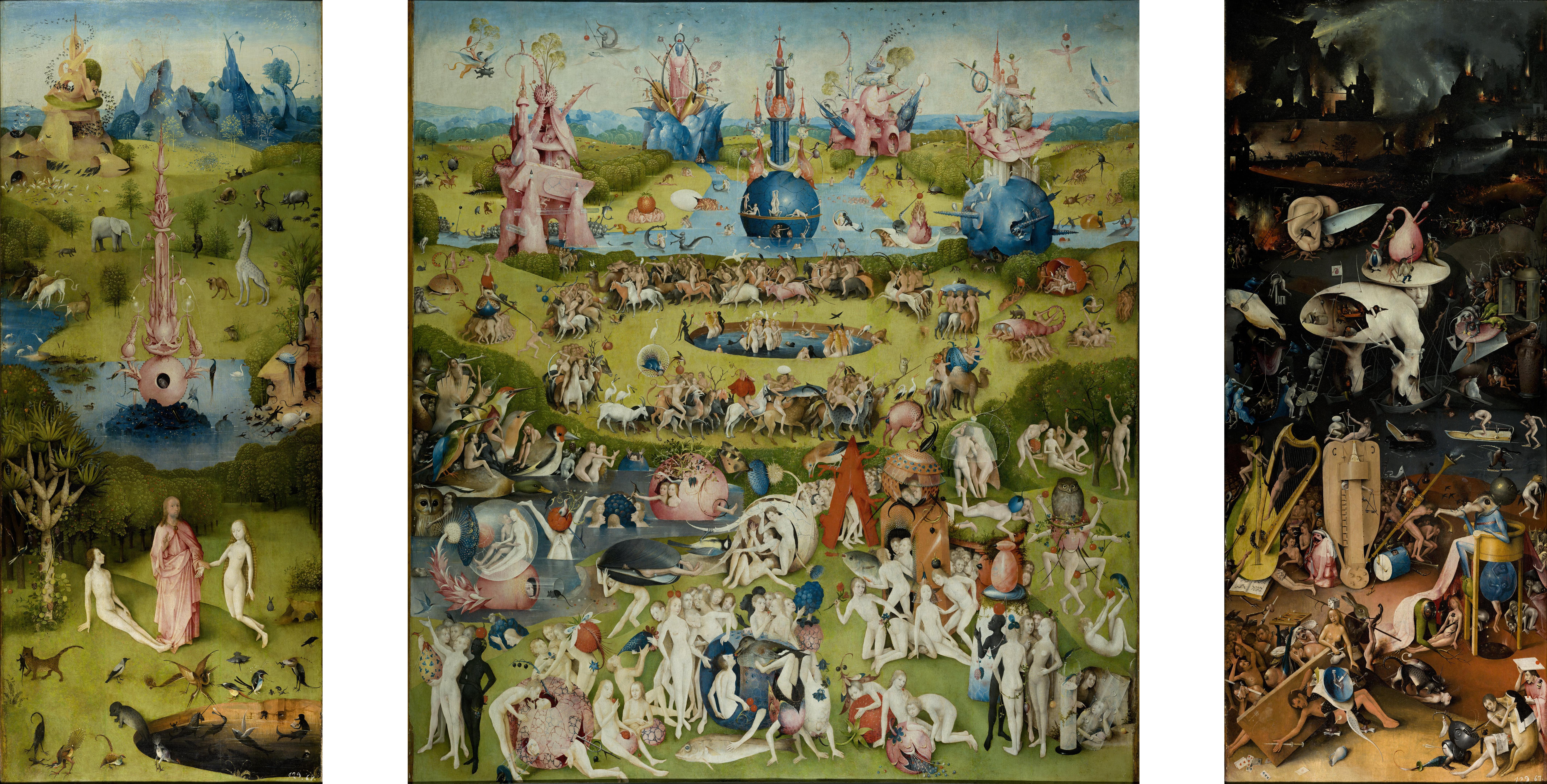Like many titles given to works of art, The Garden of Earthly Delights does not describe the subject of this painting at all. Artists normally did not give titles to their creations. Other people suggested titles, sometimes centuries later, and they often would stick.
About one hundred years ago, art historians thought that Hieronymus Bosch was a heretic because of the sensual nature of the imagery in this painting. It appears, however, that the opposite is true: Bosch was a devout Christian and this painting presents a powerful moral argument for the abstinence of sin.
The precise meaning of this painting is often debated. Some art historians believe it is a vision of earth after the Creation and before the Flood and others have found symbols associated with alchemy. It possibly depicts the false paradise that appears in the Roman de la Rose. More recently, scholars suggest the subject is from humanist writings (literature by Renaissance scholars who were interested in relating ancient philosophy to Christianity and the human condition). At the very least, it is a strict warning against human sin and folly.
God introduces Adam and Eve on the left side of the interior of the altarpiece. Some type of mating ritual appears in the background of the center panel where personifications of human souls frolic throughout the landscape. Some pair off and others eat fruit, which is symbolic for indulging in sensual pleasure. On the right, Bosch created a terrifying scene of Hell where each human soul is tortured in accordance with his or her personal deadly sin: gluttons are eaten, misers defecate money, and a vain woman is destined to admire herself on the backside of a demon for all eternity. Human souls are impaled on musical instruments. Making music was a metaphor for making love and these sinful beings will suffer forever fulfilling their passions.
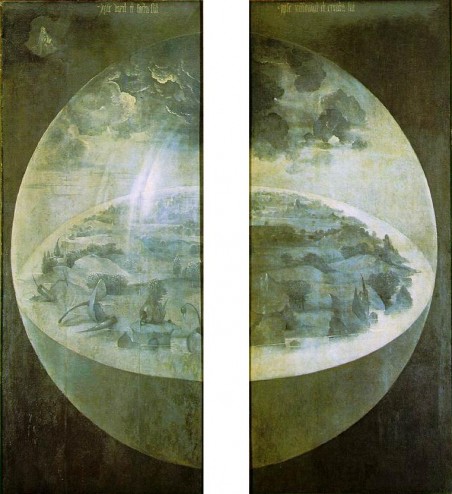 Exterior, Hieronymus Bosch, Garden of Earthly Delights, c. 1480-1515, oil on panel, center 7’2½” x 6’4½”, wings, each7’2½” x 3’2”, Museo del Prado, Madrid. Image via Wikimedia Commons.
Exterior, Hieronymus Bosch, Garden of Earthly Delights, c. 1480-1515, oil on panel, center 7’2½” x 6’4½”, wings, each7’2½” x 3’2”, Museo del Prado, Madrid. Image via Wikimedia Commons.
The exterior is painted in grisaille, which is an art historical term for gray. It shows the third day of Creation. God appears as a tiny figure in the upper left corner, uttering the words from the Psalm of David 33:9: “For he spake and it was done; he commanded and it stood fast.”
Image Details
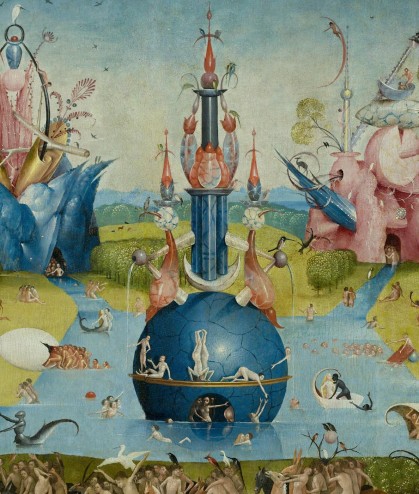 Detail, Interior, Hieronymus Bosch, Garden of Earthly Delights, c. 1480-1515, oil on panel, center 7’2½” x 6’4½”, wings, each7’2½” x 3’2”, Museo del Prado, Madrid. Image via Wikimedia Commons.
Detail, Interior, Hieronymus Bosch, Garden of Earthly Delights, c. 1480-1515, oil on panel, center 7’2½” x 6’4½”, wings, each7’2½” x 3’2”, Museo del Prado, Madrid. Image via Wikimedia Commons.
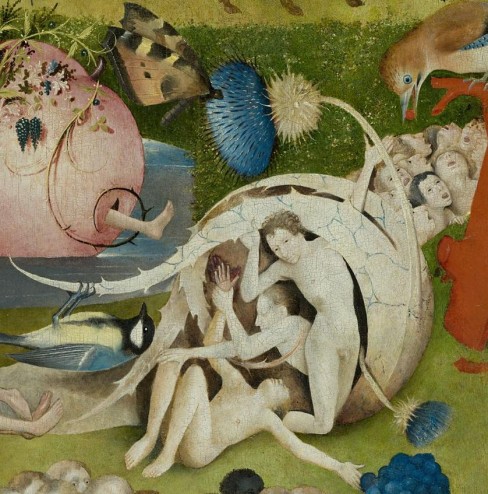 Detail, Interior, Hieronymus Bosch, Garden of Earthly Delights, c. 1480-1515, oil on panel, center 7’2½” x 6’4½”, wings, each7’2½” x 3’2”, Museo del Prado, Madrid. Image via Wikimedia Commons.
Detail, Interior, Hieronymus Bosch, Garden of Earthly Delights, c. 1480-1515, oil on panel, center 7’2½” x 6’4½”, wings, each7’2½” x 3’2”, Museo del Prado, Madrid. Image via Wikimedia Commons.
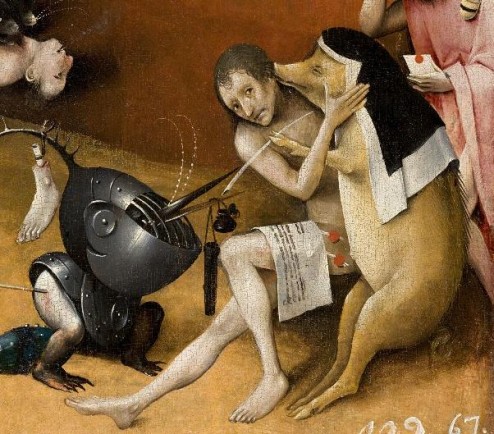 Detail, Interior, Hieronymus Bosch, Garden of Earthly Delights, c. 1480-1515, oil on panel, center 7’2½” x 6’4½”, wings, each7’2½” x 3’2”, Museo del Prado, Madrid. Image via Wikimedia Commons.
Detail, Interior, Hieronymus Bosch, Garden of Earthly Delights, c. 1480-1515, oil on panel, center 7’2½” x 6’4½”, wings, each7’2½” x 3’2”, Museo del Prado, Madrid. Image via Wikimedia Commons.
Sally Coleman | The Art Minute
Other works of art by Hieronymus Bosch
[nggallery id=5]
Recommended Reading

